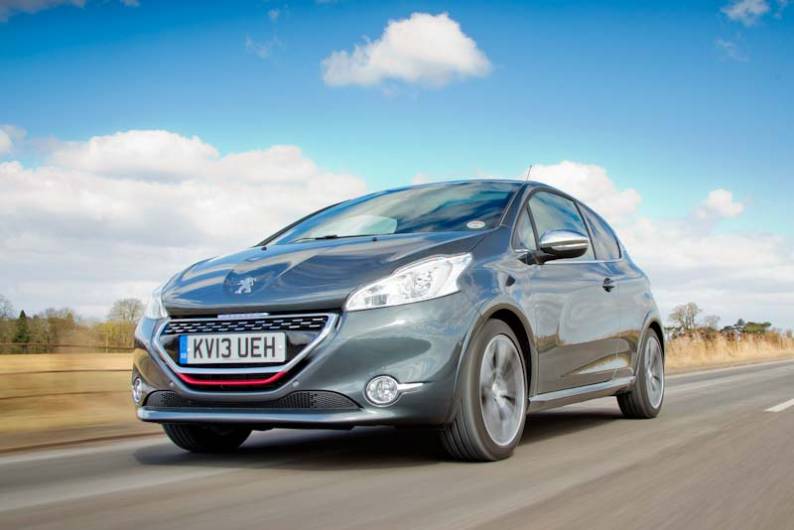
RAC sale – up to 33% off*
• Roadside cover from £5.29 a month†
• We get to most breakdowns in 60 mins or less
• Our patrols fix 4/5 breakdowns on the spot

By Jonathan Crouch
Introduction
Back in 2012, while the motoring press may have wanted Peugeot's 208 GTi to be a raw, uncompromising hot hatch, the French brand instead went its own way and brought us something that, though still huge fun, was actually quite a bit more sophisticated than that. A car for people who might remember this model's iconic 205 GTi Eighties predecessor but these days want something that doesn't put them through the wringer in delivering its best, something a bit more grown-up. It's a class act. And an interesting used buy.
Models
3dr Supermini (Petrol - 1.6 [208hp])
History
It seems that it's impossible to consider a verdict on Peugeot's 208 GTi without harking back to its legendary predecessor, the 205 GTi we first saw in 1984. Contemporary hot hatch road tests lament the fact that in contrast to that iconic car, modern shopping rockets are too fat, too grippy and too safe, testers getting all dewy-eyed as they reminisce about the time they entered a beet field backwards at 85mph in a 205. Ah, the nostalgia of being out of control, surrounded by metal with the structural integrity of a Sprite can.
Nope, we'll take a modern hot hatch any day and put up with a little less mid-corner throttle adjustability in exchange for things like air conditioning, a decent stereo, turbocharged grunt, seats that fit, an engine that can cover big mileages without issue and a dashboard that doesn't twitter like the queue at a One Direction gig. We're silly like that.
So though we'll accept that some potential 208 GTi buyers may have had a 205 GTI on their bedroom wall as kids, we're also as sure as Peugeot was at the launch of this car in 2012 that these people these days look for something better built, more comfortable and safer while still delivering excitement when they want it. That last bit is important and very much defines what this car is all about. You might well be able to buy faster supermini-based hot hatches from this period and you can certainly buy ones that deliver a bigger adrenaline rush, but this 208 is a car very much designed to respond to your moods rather than constantly imposing its personality upon you. If you've grown out of being dictated to, you're probably going to like that a lot.
There were standard and plusher 'Prestige' models available. Both were facelifted for the 2015 model year, at which point a top 'Peugeot Sport' variant was added in to the top of the range. The 208 GTi sold until 2018.
What You Get
List them and the 208 GTi has all the requisite hot hatch design cues but it's not the most instantly pugnacious of shapes. In fact, it's a bit like that movie where Elijah Wood starred as knife wielding football thug - all a bit too cuddly to take entirely seriously. There's a lower ride height and a wider track, plus the front end came in for some styling budget with the halogen headlamps featuring LEDs for the directional indicators and daytime lighting. They're lights that frame a mesh grille with bright chrome inserts and what's claimed to be a '3D chequered flag' effect.
There are gently blistered wheel arches housing good-looking 17-inch alloy wheels, while the chromed trim strip at the C pillar tips the hat to the old 205 GTi which, like this car, was only offered in three-door form. The rear end is finished with a gloss black rear skirt from which the exhaust emerges with a trapezoid chromed double tailpipe. Whichever colour you choose for your 208 GTi, there are always red highlights, from the GTi quarter panel to the brake calipers, grille lower bead and in the Peugeot scripts on the tailgate and grille. It's all neatly done, looks agreeably cohesive but isn't going to unduly scare slower, more timid road users when you roar up their rear view mirror. Maybe that's the point.
Drop inside, easing yourself into the thickly-bolstered Nappa leather-trimmed red-stitched sports seats, and you're greeted by the 208's trademark low and tiny steering wheel and relatively high seating position. If you've not come across this layout before, the set-up is that instead of peering through a big wheel at the instruments as you would normally do, you view the high-mounted dial pack over the top of the red-stitched leather-trimmed rim of a much smaller wheel. It takes a bit of getting used to and if you want to be able to see the dials, you need to lower the flat-bottomed wheel so it's almost brushing your thighs, so drivers who insist on assuming a semi-reclined, straight armed driving position may find that the wheel rim obscures part of the instrument cluster. Most will find a seating compromise that works though and once you've adjusted to the whole arrangement, you'll probably end up preferring it to something more conventional.
Once you've got yourself comfortable, take a look around and you'll find that there's a lot going on here. We're not sure that all of the decor works - the red fade to black on the door handle and the centre console trim is questionable and the aluminium detail on the dash top creates a nasty reflection in the windscreen. Otherwise it's hard not to be impressed by the quality feel in the cabin. And there are plenty of lovely touches: the aluminium pedals, the red-framed instrument cluster and the stitched marker on the steering wheel to indicate the straight ahead position. Drivers' stuff.
Button clutter was kept to a minimum too mainly thanks to the provision of what looks like a tablet PC attached to the fascia. The 7” multifunction colour infotainment touch screen offers access to radio, Bluetooth 'phone functions and downloadable apps, plus most early owners paid a few hundred pounds extra to add satellite navigation to it. You'd expect the bulky sports seats to leave rear seat passengers in this three-door-only model a bit squeezed for legroom - which is true, though we should point out that the long-ish wheelbase of this 208 means that back seat folk are better off than they would be in some other rivals - there's 50mm more legroom than, for example, you'd get in a rival Fiesta ST from this period. Headroom for tall rear passengers isn't quite so impressive.
The boot isn't bad size at 285-litres, a little less than you'd get in a rival Renaultsport Clio it's true but a pretty decent size compared to the 276-litres you get in a Fiesta ST and the 236-litres you're left with in a SEAT Ibiza Cupra from this time. It's a decently shaped cargo area too, with minimal intrusions and a fairly low loading lip. There's also a 60/40 split rear seat though it doesn't quite fold flat. Still, if you do push it forward, there's a useful 1,076-litres of fresh air to play with across a space wide enough to carry a lot more than you might expect.
What You Pay
Please fill in the form here for an exact up-to-date information.
What to Look For
This 208 GTi has enjoyed a far better reliability record than its problematic predecessor, but there are a number of things you should check over when looking at the cars. The most common things we came across in our ownership survey were steering that creeks in the cold (meant to be an easy fix) and the engine check light coming on randomly. One owner had thermostat problems, a failing clutch slave cylinder and an oil water heat exchanger leaking/mixing oil into the coolant. Plus there was a swollen seal on the coolant cap, causing heat problems.
Otherwise, it's the usual 208 issues for this generation. Examine for flaking of paint on the bumpers and check that the air conditioning works and that the pixels on the centre display are all good. Also check for rear bumper scrapes. Finally check that the Bluetooth pairs reliably with your phone handset. Electrical glitches are relatively common, so make sure everything electrical in the car works and double-check that there are no unexplained warning lights on the dashboard.
Peugeot's infotainment touchscreen software can sometimes cause the monitor to freeze or fail completely. A software reset may solve the problem, but some owners have had to replace the entire unit, which is not a cheap operation. Ten manufacturer recalls were issued on the 208, the largest of which involved replacement of the front suspension wishbone mounting bolts, a batch of which were found to break and result in loss of steering control and vibration from the front of the car. Obviously, you'll want to make sure this has been done.
Finally, a full service history is essential as this engine needs clean, good quality oil. As it's a hot hatchback, check the brake pads and discs for signs of hard use, while the car battery could also be on the way out.
Replacement Parts
(approx based on a 2015 208 GTi excl. VAT) A pair of front brake pads are between £14-£48 depending on brand. A pair of rear brake pads are between £11-£22. A pair of front brake discs start in the £37 bracket, but you can pay well over £135 for pricier brands. A pair of rear brake discs sit in the £115-£195 bracket. A water pump costs around £62-£66. Air filters sit in the £7-£21 bracket. Oil filters cost around £4-£7 and a radiator sits in the £71-£80 bracket. A rear lamp sits in the £115 bracket; a headlamp is around £248. A waper blade is around £10 and a pollen filter is around £9-£28.
On the Road
So, what's it like? Well, Peugeot certainly didn't skimp when it came to the hot hatch mood mood here. Jump in and you get a tiny steering wheel with a chunky rim and contrast stitching, plus figure-hugging seats, an aluminium pedal set and gear lever and more black and red than you can shake a stick at.
Other parts of the car are resolutely traditional. In contrast to some rivals from this period, there's no faddy starter button to press, no fiddly electronic handbrake to worry about and no flappy-paddle gearbox to get to grips with. This means that you feel at home with the 208 right from the get go. Key the engine and despite what's described as a 'sports exhaust', there's a notable lack of aural drama, though plenty of visual compensation as the instrument needles glow white, then swing through their full scale and back, the numbers illuminate and then a pair of red LED rings around each clock flicks into life. You're ready.
Once on the road though, this feels nothing like the car the racy trimming leads you to expect. The steering's light and the ride quality's actually quite cosseting in its own expensive-feeling way. And in place of the kind of peaky performance engine that you might think would characterise any self-respecting hot hatch, there's a turbo 1.6 with a lazy, long-legged feel that makes this Peugeot easy to punt around in when you're not in the mood to flog the thing to death. As a result, the 208 GTI makes a better citycar than almost any little GTi from this period we can think of.
Here is a real world approach to shopping rocket motoring, one realising that, much as you might like your route to work to take in empty, cresting Welsh border backroads, it's actually more likely to be punctuated by traffic jams, potholes and urban misery. It's also an approach accepting that a performance car developed on a super-smooth racetrack is often unlikely to be very good on a typical bumpy British country lane. So while rival brands boast that their cars were developed with hundreds of laps around the Nurburgring Nordschliefe, Peugeot engineers are actually proud to tell us that they never bothered.
Has that brought the kind of compromised end result that some magazine testers have suggested is delivered when you really start to push this thing along? We don't think so. Let's start with motive power, the engine a 200PS version of the same award-winning 1,598cc turbo unit you'll find in everything in this period from a MINI Cooper S to top versions of Peugeot's own RCZ super-coupe. Benign it may be at the lower reaches of the rev range but plug into the meat of the power curve from 2,000rpm onwards and you'll find this car quite able to match any of its direct hot hatch rivals punch for punch.
There's 275Nm of torque on offer, significantly more than you get in, say, a Renaultsport Clio 200, quite enough muscle to pile on speed with real verve, 62mph from rest flashing by in just 6.8s en route to 143mph and the more important 50-75mph 5th gear overtaking increment dispatched in just 7.0s flat. It'd probably be a few tenths quicker still if it had the kind of twin-clutch steering wheel paddle auto transmission that rival Renault, SEAT, Volkswagen, Skoda and Audi hot hatch models from this period insist on giving you, but the manual on offer here is a really strong 'box, albeit a bit long in the throw. Use the six-speeder to its limits and you'll be able to plug the engine right into the good bit of the turbo's action through each gear.
To be honest, you'd appreciate all this performance a bit more if it was delivered with a bit more of a rasp and a crackle - the kind of thing you get from the rival Ford Fiesta ST's artificial sound symposer or indeed the trick exhaust system used on Peugeot's own RCZ. But then, the development team behind this car would probably counter that video game sound effects don't really fit with this 208's more mature image. We've already touched upon the way that character trait is emphasised by the supple ride quality, something that on a race track at higher speeds would deliver a little more float in the suspension than you'd find in rival Renaultsport Clio or Fiesta ST models. Through really tight corners, you might also miss the limited slip differential and/or torque vectoring systems that rivals provide to better get the power down. Overall though, on public roads, unless you're travelling at the sorts of speeds that would get you an instant custodial, that becomes a non-issue, the Peugeot engineers having hit on a ride and handling compromise that works really well for most people most of the time.
If you want the detail, we're talking higher rate springs, beefier dampers, a wider track and a chunkier anti roll bar but we think the development team were probably helped most by the fact that the suspension has less work to do. This may be a bigger car than the its 207 GTi predecessor but it weighed in 110kgs lighter. Can you feel the difference that makes? Absolutely. It's like dropping your seventeen-stone mate off at home and then driving back the same route. The beefy brakes seem more effective as they've less to stop and the whole car feels sharper and more vivid than before. You brake later, turn in easier and ride dips and crests with more composure.
At which point, you might find yourself with a few conflicting feelings over the steering, always a vital part of the hot hatch experience. No, it isn't quite as feelsome and responsive as some of the set-ups you'll find elsewhere: the electric assistance means there's no real feel of kickback, judder or torque steer coming back through the wheel - but then that can sometimes help when you're battling with the car on a really bumpy backroad. Anyway, in compensation, there's plenty else to like, this small wheel rim delivering wrist-flick responses and maintaining the kind pointy, direct front end feedback you want from a GTi of this kind. It doesn't feel as immediately connected to every grain of the road surface as you'd experience in, say, a Fiesta ST, but there's real talent here. You just need to learn to place your trust in it.
Overall, as we've been suggesting all along, there's a subtlety about this GTi that will be lost on some. It has facets and layers to its skill set and in a shopping rocket market that's all about the quick hit and the instant one-minute pitch, there's something quite refreshing about that.
Overall
Peugeot will never build a true spiritual successor to the 205 GTi. Times have changed and the things that made that car great such as its sub-900kg weight and spiky handling just won't pass safety legislation and quality demands these days. Upset? Toughen up. The game's changed and changed for the better. The appeal of disappearing backwards through a hedge palls somewhat with age.
So let's move into the here and now and cast a final spotlight on this 208 GTi, a car that's that rarest of things - a hot hatch with maturity, subtlety and versatility, one that blends fun with responsibility. This might not be immediately apparent when you first clap eyes on it. All the red and chrome bits lead you to expect a bit of a handful but it's anything but. This thing doesn't drive like a pocket rollerskate. It's fun, yes, but in a more grown up way. There's not that ADHD persistence of the most focused cars in its class.
So does that mean that rivals from the 2012-2018 period like Ford's Fiesta ST and the Renaultsport Clio 200 will be more fun around a race track? In all likelihood yes, but day-in day-out, we can see a significant number of potential buyers preferring to take the Peugeot, provided they've taken the trouble to delve a bit deeper into what it offers. Do that if you're browsing in this segment: this 208 GTi will reward you for it. If you suspect that you might have grown out of a hot hatch and rue that fact, then this is the car for you. It's a hot hatch with the nagging edginess smoothed away and do you know what? That makes this car a rather lovely thing.







